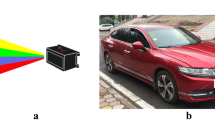Abstract
Pedestrians are one of the most important elements in traffic scenes. In autopilot system, pedestrians need to be accurately detected. We found the latest research that 3D light detection and ranging (LIDAR) sensors can provide more accurate pedestrian location information. In this paper, the AdaBoost algorithm is used to improve the accuracy of the support vector machine (SVM) and high-accuracy pedestrian detection based on real-time 3D point cloud data. The first step is to process 3D points to 2D grid, followed by using k-means clustering algorithm to extract candidate points of the pedestrian. Next, nine features are chosen to train the SVM, the AdaBoost iterative process is used to reduce the further error rate to meet the classification requirements. This method has achieved significant progress in our experiment, the average classification accuracy has been improved to 92.4% per scan.
Access this chapter
Tax calculation will be finalised at checkout
Purchases are for personal use only
Similar content being viewed by others
References
Yamamoto T, Kawanishi Y, Ide I et al (2018) Efficient pedestrian scanning by active scan LIDAR. In: 2018 international workshop on advanced image technology (IWAIT). IEEE, pp 1–4
Jun W, Wu T, Zheng Z (2016) LIDAR and vision based pedestrian detection and tracking system. In: IEEE international conference on progress in informatics and computing. IEEE
Lin Z, Hashimoto M, Takigawa K et al (2018) Vehicle and pedestrian recognition using multilayer lidar based on support vector machine. In: 2018 25th international conference on mechatronics and machine vision in practice (M2VIP). IEEE, pp 1–6
Lin TC, Tan DS, Tang HL et al (2018) Pedestrian detection from lidar data via cooperative deep and hand-crafted features. In: 2018 25th IEEE international conference on image processing (ICIP). IEEE, pp 1922–1926
Kidono K, Miyasaka T, Watanabe A et al (2011) Pedestrian recognition using high-definition LIDAR. In: 2011 IEEE intelligent vehicles symposium (IV). IEEE, pp 405–410
Spinello L, Arras KO, Triebel R et al (2010) A layered approach to people detection in 3d range data. In: Twenty-fourth AAAI conference on artificial intelligence
Teichman A, Levinson J, Thrun S (2011) Towards 3D object recognition via classification of arbitrary object tracks. In: 2011 IEEE international conference on robotics and automation. IEEE, pp 4034–4041
Dewan A, Caselitz T, Tipaldi GD et al (2016) Motion-based detection and tracking in 3d lidar scans. In: 2016 IEEE international conference on robotics and automation (ICRA). IEEE, pp 4508–4513
Asvadi A, Peixoto P, Nunes U (2015) Detection and tracking of moving objects using 2.5 d motion grids. In: 2015 IEEE 18th international conference on intelligent transportation systems. IEEE, pp 788–793
Kaestner R, Maye J, Pilat Y et al (2012) Generative object detection and tracking in 3d range data. In: 2012 IEEE international conference on robotics and automation. IEEE, pp 3075–3081
Huang J, You S (2016) Point cloud labeling using 3D convolutional neural network. In: 2016 23rd international conference on pattern recognition (ICPR). IEEE, pp 2670–2675
Tang HL, Chien SC, Cheng WH et al (2017) Multi-cue pedestrian detection from 3D point cloud data. In: 2017 IEEE international conference on multimedia and expo (ICME). IEEE, pp 1279–1284
Douillard B, Underwood J, Kuntz N et al (2011) On the segmentation of 3D LIDAR point clouds. In: 2011 IEEE international conference on robotics and automation. IEEE, pp 2798–2805
Premebida C, Ludwig O, Nunes U (2009) Exploiting lidar-based features on pedestrian detection in urban scenarios. In: 2009 12th international ieee conference on intelligent transportation systems. IEEE, pp 1–6
Navarro-Serment LE, Mertz C, Hebert M (2010) Pedestrian detection and tracking using three-dimensional ladar data. Int J Robot Res 29(12):1516–1528
Keerthi SS (2002) Efficient tuning of SVM hyperparameters using radius/margin bound and iterative algorithms. IEEE Trans Neural Netw 13(5):1225–1229
Schapire RE, Singer Y (1999) Improved boosting algorithms using confidence-rated predictions. Mach Learn 37(3):297–336
Acknowledgments
This work was supported by the Beijing Municipal Science and Technology Project under Grant # Z181100008918003 and the National Key Research and Development Program of China (2016YFB0101001). The authors would also like to thank the insightful and constructive comments from anonymous reviewers.
Author information
Authors and Affiliations
Corresponding author
Editor information
Editors and Affiliations
Rights and permissions
Copyright information
© 2020 Springer Nature Singapore Pte Ltd.
About this paper
Cite this paper
Guo, C. et al. (2020). Research on Vehicle Forward Pedestrian Recognition Based on Multi-line LIDAR. In: Jia, Y., Du, J., Zhang, W. (eds) Proceedings of 2019 Chinese Intelligent Systems Conference. CISC 2019. Lecture Notes in Electrical Engineering, vol 594. Springer, Singapore. https://doi.org/10.1007/978-981-32-9698-5_59
Download citation
DOI: https://doi.org/10.1007/978-981-32-9698-5_59
Published:
Publisher Name: Springer, Singapore
Print ISBN: 978-981-32-9697-8
Online ISBN: 978-981-32-9698-5
eBook Packages: Intelligent Technologies and RoboticsIntelligent Technologies and Robotics (R0)




